Our favourite places to stay on this sleepy Cebu island.
Zamboanga City: What You Should Know & Travel Tips
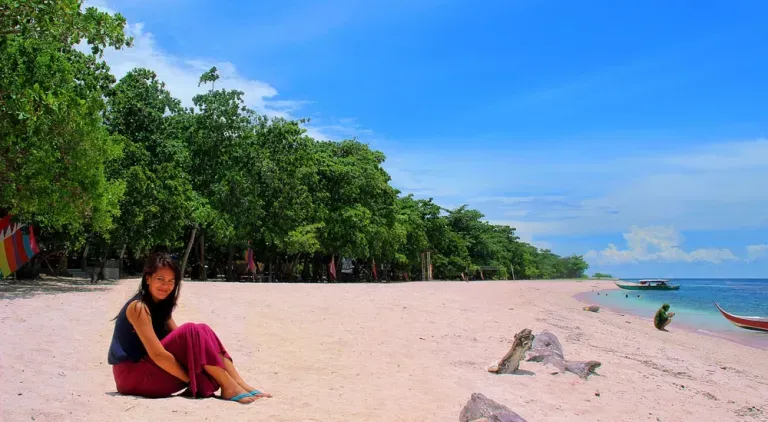
Contributed by What Distance Tells Us
The laconic escort wearing an orange vest marked Policia tucks the Baby Armalite between his legs. Using a camera retrieved from his pocket instead to target his subject, he aims the screen high in the air to capture presumably the approaching island of Santa Cruz.
Yet he calls my attention, shouting through the waves, “Ma’am, tingin dito.”, to face the screen as he takes our “selfwe”, the clicks of his camera battling with the roar of the motorboat.
It is high noon and we are crossing the 4 kilometers of sea dividing Centrio Latino, the city’s multi-purpose centre where their port also is, to one of the few islands in the Philippines with pink sand. The photos our escort, PO2 Jujani, took were sure to be overexposed.
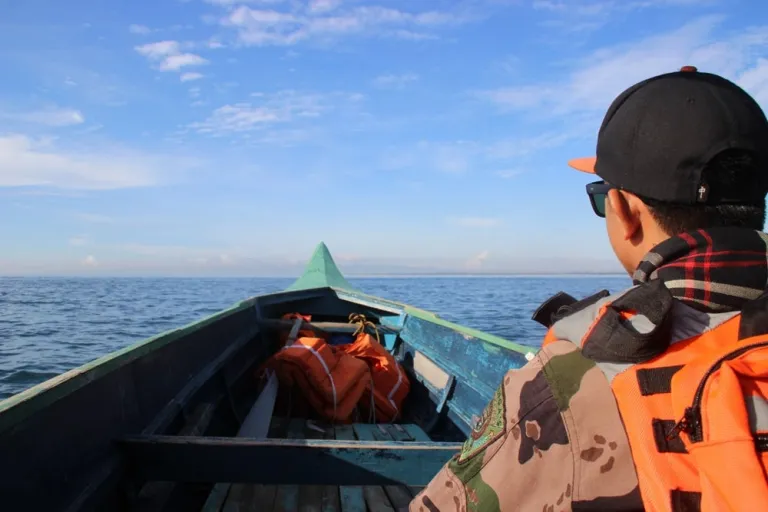 P02 Jujani escorting us for the day.
P02 Jujani escorting us for the day.
After several days in Zamboanga, firearms no longer unsettle me. They merge easily with their colonial buildings, becoming a typical sight in and around the city – in City Hall, in Fort Pilar, in checkpoints stopping jeepneys and tricycles – more so perhaps with the first year anniversary of the siege coming in a few days’ time. September 9. There is a hush in the streets that can only come from a collective holding of breath.
Prior to my coming, I did not understand terms like “siege” or “red alert”, just as I did not understand what the war down South was about. Being in an archipelago makes one prone to partisan reality. There is no war because war has not affected me.
All I knew was Zamboanga was a place to be avoided. As to why, I was not exactly sure. Conflict perhaps was treated like a disease. Touch it, and be contaminated.
Any traveller will tell you though that there are places that inexplicably pull. It starts with a soft affirmation, a pin on the map. Or perhaps it starts with a name, the easy roll of syllables on the lips like a song. Zam-bo-wang-ga.
Also read: 12 Exciting Things to Do in Zamboanga City
A week before, I clicked on a headline in my newsfeed, “Draft Bangsamoro Law expected to pave the way for lasting peace.” when previously, I would’ve just been as equally content clicking on posts like “100 days of Happiness.”
Whatever the irrational, undefined sensation is to go, it grows restless until such time that the traveller surrenders to it. It is fatalistic intuition.
Strolling around the city on my first day, I spot an oversized tarp on the front of the University of Zamboanga that serves as a tally board for the number of gunshot victims from 1 Jan 2012. 275, it said. “And still counting…” Citizens and tourists are asked to take extra precautions. The city is in a state of double red alert. It is a city still not allowed to breathe.
 Steamed kuray and kagang eaten on age old Yakal picnic tables.
Steamed kuray and kagang eaten on age old Yakal picnic tables.
But picking on the meat of kuray, local crabs that have a subtle smoky flavour, on the shores of Santa Cruz, sitting on Yakan picnic tables and watching the pastel shades of pink change from non-existent to a soft blush as water laps over sand, there is a conscious need to exhale, to pause the impending.
“Kung sa amin lang, mas mabuti yung palaging double red alert.” says Milabel, my guide. Better that way, she adds, in order for everyone to feel fully safe again.
Tagalog is the language we automatically agreed upon in lieu of our mother tongues. She understands most of my Bisaya. I understand nothing of her Chavacano, each word taking on an aristocratic air. Buenos Diaz, she greeted me the morning of my arrival. Como esta?
Even the most ordinary signs take on a lyrical foreignness. For toilet designations, Hombre, Male. Mujer, Female. Hasta la Vista. Until we meet again, says a quixotic sign when leaving a barangay. And Sensilyo Lang sa Umaga Por Favor Para Hayahay, urges a sticker on the jeepney.
Milabel saw Zamboanga on its best days, before the travel ban that prevented foreign tourists from visiting the city over seven years ago. In those days, she says, the city would run out of hotels. Accommodations were unable to cope with the influx of travellers.
Now, dark red tarps are placed in establishments – in malls, bakeshops, universities – as a constant reminder from the local government to “No te Vayas de Zamboanga.” Do not leave Zamboanga.
When I ask her if she misses the way it was, she gives me a trite smile and with a smoker’s voice murmurs “Yes.”
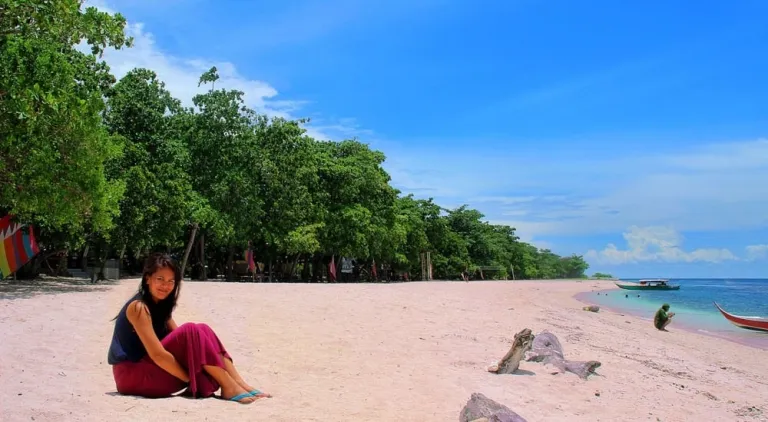 The writer sitting on very rare pink sand, caused by sediments of red corals mixing with the white sand.
The writer sitting on very rare pink sand, caused by sediments of red corals mixing with the white sand.
Pink Sand in a Blue Sea
Vinta sails decorating the beachfront sway with the easy breeze of an adequately-sunny day. From the shore, Milabel demonstrates the best way to open a crab that will still leave its fat intact. She cracks open a shell to show layers of orange fat, one of the ingredients for the famous Alavar sauce, her favourite topping.
“Add some fat, curry powder, tomato sauce, coconut milk and—I’m revealing our secret na, ha”, Milabel stops short of telling me.
It seems everyone has their own recipe for crabs in Zamboanga, as many perhaps as the type of crustacean in the area, from kagang, small mangrove crabs, to curacha, a crustacean which looks somewhat like a mutation between a lobster and a frog, with legs splayed, front pincers bowed in surrender.
 Red Corals that are the reason for the island’s rare pink sand.
Red Corals that are the reason for the island’s rare pink sand.
Earlier, a local took us to the muddy part of the island’s mangroves. He stomped on small, elevated mud holes, and out came small orange miniature crustaceans only about an inch long. They were fiddler crabs, small critters whose males have one overgrown pincer and one normally-sized one that make them look like they were, well, fiddling.
It is no surprise that Zamboanga’s major income generator is marine products. In its Northern district are canning factories of national sardine players like Family’s Brand, Master Sardines, Mega, Ligo and 555. Big fish and lobsters too are taken out of Zamboanga’s waters and exported to major cities like Cagayan de Oro and Cebu.
The island’s keeper says that during the 21-day siege, the Navy stalled exit from Santa Cruz. No supplies, including potable water, a perennial problem in the island, entered as well. Locals had to scrounge whatever they could find in the area for sustenance. They fed on crabs, squids, lobsters, fishes, birds, sea cucumbers and wild lato.
Zamboanga City, Milabel shares, has a Zero Poverty incidence rate. “Walang nagugutom sa amin. What you see in the news are refugees. Well, they’re a different story.” and she leaves it at that.
Talk of the siege is often quick and sporadic. Perhaps it was the crabs doused in vinegar, but conversations such as these take on a sweet-sour taste.
“Kung minsan naman kasi, hindi naman sa Zamboanga nangyayari yung gulo peru dahil dito yung source sa news, linalagay nila Zamboanga City.”, complains Milabel. “Sana, they’re fair enough naman.”
She is referring to conundrums in neighbouring areas like Basilan, Jolo, Tawi-Tawi that are somehow thrashed to Zamboanga’s name anyway. Even the confusion of provinces and designations add on to the misnomer. Conflict in the rest of the peninsula such as in newly-formed Zamboanga Sibugay or in the rest of Zamboanga del Sur are still thrown to one name.
I wanted to ask my companions what they fully thought as I lay them with question after question, but they fall silent. I have overplayed this angle, I sense, looking at the transparent blue of the sea ahead of me. They want to portray, after all, that Zamboanga is not just all conflict, and yet I have asked about very little else. I had learned perhaps to care a year too late. Such is the encounter between those who want to know more and those aiming to forget. Milabel walks me to the women forming a semi-circle, selling baubles. It is lunch time and some of them are cooking dried fish and mais.
Now clad in his undershirt to take in some fresh air, PO2 Jujani relaxes under the shade of a Talisay nearby. Seeing us approaching, he jumps off the seat with his camera and with an impish grin says, “Ma’am, pa-picture tayo.”
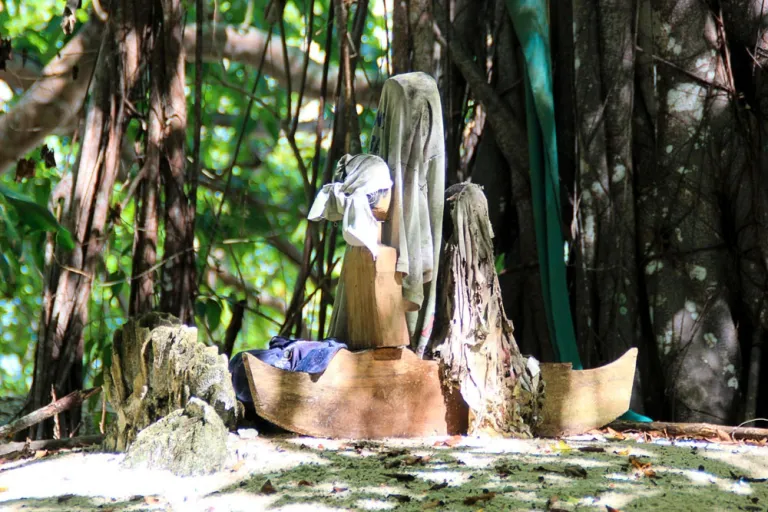 Markers at the Sama-Bangingi burial site.
Markers at the Sama-Bangingi burial site.
A Vinta’s Colours
“Be careful. There might be sea snakes hiding.” Milabel warns as we dock off to a concealed cemetery for the Sama-Bangingi a few steps away from the sea. At high tide, it seems the water might just reach the closest grave.
All around, there is an overgrowth of tayumtayum, plants that look like sea urchins. Dried leaves and broken branches cover markers. Chipped cups left confirm that someone has been here, once. How long ago, no one can tell anymore. There is a type of silence gathered from a dwelling that hasn’t been disturbed in a while.
The graves do not carry names. What serves as markers are carved wooden boats on the centre of a square perimeter. “They’re pagans.” the keeper says of the Sama-Bangingi, a water-dwelling tribe, so no symbols are needed for their resting place.
“Like the Badjaos?” I ask.
The island keeper shakes his head. “They are not allowed here.” They are, to many tribes, nomads. And nomads to the territorial are ex-communicated.
He isn’t too keen on the details of anthropological significances, and even if he was, I would probably not have been able to absorb it. In Zamboanga, tribes I only read in books in long-forgotten history lessons are very much alive. They walk amongst the living, in streets, in coastlines and in villages that somehow still follow a bygone era’s way of life. Never mind that they’ve had to succumb to present-day commercialisation.
The Yakans, Tausugs, Samals, Badjaos and Subanens seem to carry a conscious ancestry. A security guard I talked to says he is partly Tausug, natives from Jolo. A street vendor says she is partly Yakan, natives from Basilan. Their village in the Northern part of the city has somehow kept their weaving culture intact. Most of the people in the outskirt community there are, in one way or the other, partly Yakan. The Badjaos too have their own territory in the city.
Add to this the hodgepodge of beliefs. 65% of the population are Christians, with denominations that are divided into Roman Catholic, Mormon, Protestant, Adventist, Anglican and many others. 35% of the population are Muslims.
Milabel says this of Zamboanga, that if there’s one thing that they have, it’s culture, a mishmash of practices and beliefs, that it is uncertain anymore where one ends and the other begins. Perhaps this is why the vinta is an apt symbol of the city. Each sail has seven colours to symbolise the diversity in the area. And yet the recent scurf shows that diversity, more often, does not immediately equate to tolerance.
“Ba’t may pangalan tong isa?” I asked, seeing a grave with a formal Muslim headstone.
“Ah, don’t be surprised.” Another belief has already conquered one of them. And there might even be a Badjao buried somewhere amongst, the island’s keeper says. But that is something not spoken of.
White and coloured cloths that serve as tents to the graves billow in the wind. White flags apparently are for the ordinary citizens. Coloured flags are for high society. But once in a while, the island keeper shares, the worth of a person is only revealed after death.
He shows me a large mound of earth and shells at the back of the other gravestones. At the very tip is a boat marker with a tent of white flags. “Sabi nila pag nilibing na ordinaryong tao peru may dugong bughaw talaga, tataas daw yung lupa ng nililibingan nya.”
There is another one of royal blood buried in this island, a warrior who fought against the Spanish. His mound, it is said, continues to grow metres high. “But I won’t take you there.” the island’s keeper says. He promised secrecy to the people, a right he had to earn for two years of constantly going back and forth the island and even adapting their language.
There would be more secrets to the island, it seems, one still unknown even to its keeper. Shaped like a doughnut with a collection of mangroves in the middle, there are species in the area such as migratory birds that are still unnamed, trees that are still uncategorised, and perhaps graves that still remain hidden. All this in an island just 15 minutes away from the city. It does not reveal itself even with accessibility, and even to overly-curious travellers.
Before we leave, I notice small flaglets in random trees that provide shade to the graves. The balete near the shore is tied with about three or four flaglets. Panji-panji, says the keeper, to make locals aware that the trees have supernatural residents.
“We just placed those ourselves just to scare them off.”, the keeper jokes.
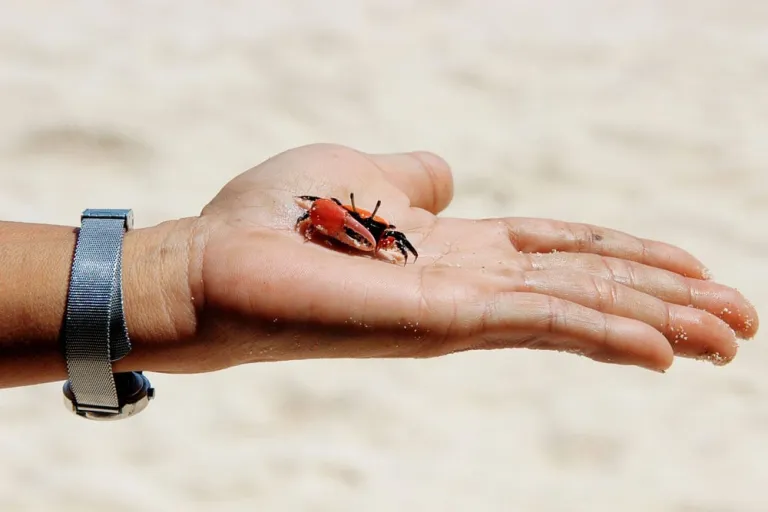 Male Fiddler crabs that are only about an inch in length.
Male Fiddler crabs that are only about an inch in length.
I return to the city in high spirits. The sun slanted in such a way that seemed to favour my direction. The flavour of crabs left a long aftertaste. And there was the novelty of touching pink sand, the gratitude of meeting new friends.
This was, of course, a day before reaching Ground Zero. This time unescorted in Santa Barbara where the crisis took place, I am greeted by the wince of half-houses, of buildings with gunshots and of burned-down stores that still have leftovers of life: a 2013 liquor calendar, a broken clock, a monoblock chair that has seen sturdier days. A friend shows me a residence, once grandiose, until the siege transformed it into an armoury. There, she points out, is corner where the Red Cross was positioned in order to easily accept casualties. And there, is the hospital that had to evacuate their patients except for the mentally ill who remained inside for most part the 3-week encounter. There is no resonance here of the calmness I just left.
More unnerving is that the two places, Santa Cruz and Santa Barbara, may just be a few kilometres from each other. Santa Cruz is, in fact, under the jurisdiction of Santa Barbara.
But this is what it means to visit Zamboanga perhaps: to understand that with every glimpse of beauty, there is an undercurrent of pain, an emotional dilemma that rises and falls with every testimony heard, a confusion that’s necessary to counter apathy or muffled empathy.
That is what travel is partly for, I think; to finally arrive to a place that allows you to go past compassion, to feel instead an overwhelming sense of pain for what each has lost, and what each is fighting for.
Most visit Zamboanga with the stubborn mission to mark the totality as misunderstood. But perhaps the more apt account is that, with so much multiplicity, each section is not understood enough. To visit it is not to come out with answers, for who can answer in quick interludes what seem to be acts of demise and degeneration. To visit is to start asking.
It is certainly not paradise. It is a place with wounds, and stories, and questions. And that is why you should go.
In the distance, I can almost hear a shout through the waves, “Ma’am, tingin dito.”
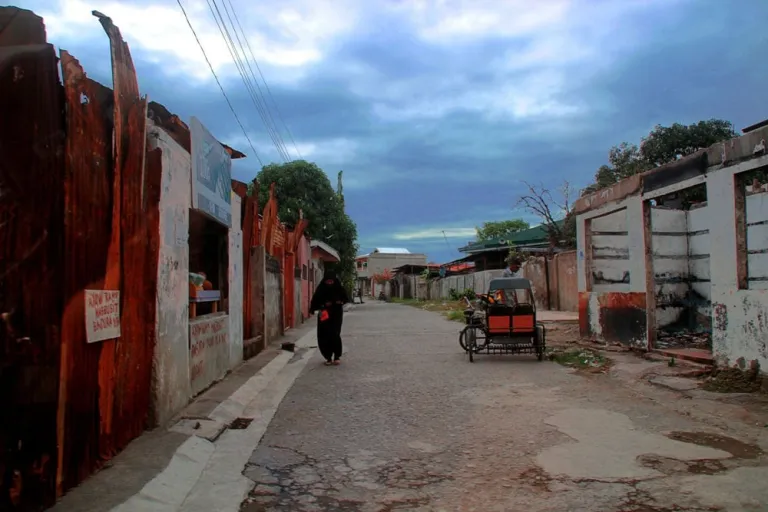 New life at Ground Zero of the Zamboanga Siege.
New life at Ground Zero of the Zamboanga Siege.
Also read: Why Zamboanga City Should Be on Top of Your Philippine Travel List
Planning to go to Zamboanga but unsure of where to start? Here are a few tips:
Visit their City Tourism Office
Whether you’re alone or with a group, it is best to visit the City Tourism Office as they usually give you the most accessible routes to the city’s spots. And if they’re feeling extra generous, they might even give you special arrangements on transportation.
Find a Tour Guide that can give you access to normally non-accessible parts of the city
 Milabel Richter on the boat, Bagong Pag-asa.
Milabel Richter on the boat, Bagong Pag-asa.
Milabel Richter brands herself as a true Zamboangena. Don’t be intimidated by the foreign surname. As one of the two certified tour guides in Zamboanga, Milabel herself is a character. She will entertain you with stories of her eight years travelling around the world with her German photojournalist partner. She will also give you access to areas normally not accessible to walk-ins in Zamboanga such as the museum on the 2nd floor of the Philippines’ first BPI Branch or some parts only known to locals in Taluksangay Village. Her rates are reasonable to boot. Contact her at 0915.54.74303.
Find ideal accommodations
Zamboanga Town Home is tucked on a side street in San Jose Road, just 10 minutes away from the Pueblo. It is one of the newest accommodations in the city. Rooms are clean, affordable and WiFi-ready. There’s a restaurant on the third floor, or a series of carenderias outside if you want to eat in. And the young General Manager, Jin, a scion of Family’s Brand Sardines, has a fresh, non-touristy perspective on where to go and what to do in the city. Contact him at their Facebook Page: Zamboanga Town Home.
Wear good walking shoes or slippers
Zamboanga City is a city that needs your feet and your footwear’s cooperation. Most of the historical sites such as its City Hall, Rizal Park, Plaza Pershing, the National Museum and Fort Pilar Shrine are a walking distance from each other. Visiting these throughout the morning and afternoon of my first day, my supposedly good sandals gave way.
Published at
About Author
Subscribe our Newsletter
Get our weekly tips and travel news!
Recommended Articles
10 Bantayan Island Resorts, Hotels, and Rentals for Your Tropical Escape 10 Best Mountain Cafes in the Philippines for Your Peak Coffee Experience Coffee date on the mountains, anyone?
10 Family Outing Ideas in Metro Manila Under ₱500 Looking for a weekend bonding with the family under ₱500? Head to these places, pronto!
10 Fun Things to Do in Manila Alone Live your best life in Manila, even when you’re riding solo.
10 Instagrammable Laguna Restaurants and Cafes You’ll Love Elevate your Insta-game at these Laguna spots.
Latest Articles
Dingalan Travel Guide: Nature Spots to Discover Now Underrated coastal gem in Aurora
What to Eat in Bicol: Iconic Dishes and Treats, and Unique Pasalubong You’ll Love Spice up your foodie adventure with iconic Bicol dishes and must-try pasalubong!
Top Travel Trends in the Philippines for 2025 New spots, tips, and trends
New UK Adventure Park to Visit in Devon and Cornwall Fun countryside escape near London
Ultimate Camarines Norte Travel Guide: Waterfalls, Beaches, and More From surfing to secret waterfalls, Camarines Norte is your next escape!

